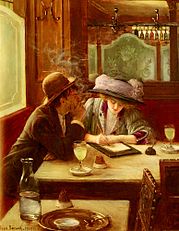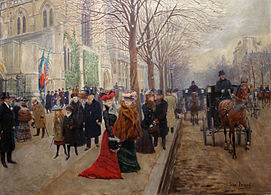| Jean Béraud | |
|---|---|
 Self portrait (ca. 1909) Self portrait (ca. 1909) | |
| Born | (1849-01-12)January 12, 1849 Saint Petersburg |
| Died | October 4, 1935(1935-10-04) (aged 86) Paris |
| Resting place | Montparnasse Cemetery |
| Nationality | French |
| Education | Salon (Paris) |
| Known for | depiction of Paris life |
| Awards | Legion of Honour (1894) |
Jean Béraud (French: [beʁo]; January 12, 1849 – October 4, 1935) was a French painter renowned for his numerous paintings depicting the life of Paris, and the nightlife of Paris society. Pictures of the Champs Elysees, cafés, Montmartre and the banks of the Seine are precisely detailed illustrations of everyday Parisian life during the "Belle Époque". He also painted religious subjects in a contemporary setting.
Biography

Béraud was born in Saint Petersburg. His father (also called Jean) was a sculptor and was likely working on the site of St. Isaac's Cathedral at the time of his son's birth. Béraud's mother was one Geneviève Eugénie Jacquin; following the death of Béraud's father, the family moved to Paris. Béraud was in the process of being educated as a lawyer until the occupation of Paris during the Franco-Prussian war in 1870.
Béraud became a student of Léon Bonnat, and exhibited his paintings at the Salon for the first time in 1872. However, he did not gain recognition until 1876, with his On the Way Back from the Funeral. He exhibited with the Society of French Watercolorists at the 1889 World's Fair in Paris.


He painted many scenes of Parisian daily life during the Belle Époque in a style that stands somewhere between the academic art of the Salon and that of the Impressionists. He received the Légion d'honneur in 1894.
Béraud's paintings often included truth-based humour and mockery of late 19th-century Parisian life, along with frequent appearances of biblical characters in then contemporary situations. Paintings such as Mary Magdalene in the House of the Pharisees aroused controversy when exhibited, because of these themes.
Towards the end of the 19th century, Béraud dedicated less time to his own painting but worked on numerous exhibition committees, including the Salon de la Société Nationale. Béraud never married and had no children. He died in Paris on October 4, 1935, and is buried in Montparnasse Cemetery beside his mother.
Style
Béraud was popular in France, and was appreciated by Guy de Maupassant who called him "adorable's adversaries" (Le plus charmant des fantaisistes).
However, his work was completely ignored by art historians of the period. After the Revolution, Russian artists received Béraud's work with irony, seeing them as the embodiment of Western commercial consumption, indulging, in their opinion, in the bourgeois tastes of the rich middle-class. Painting style gradually shifted from academic towards impressionism. However, while the major Impressionists fled the chaotic milieu of Paris and painted landscapes of the surrounding areas, Béraud – like his friend Édouard Manet (1832–1883), and in some of his paintings, Edgar Degas (1834–1917) – depicted the busy environment of late-nineteenth-century urban life. Artistic techniques used by Béraud, in particular, when drawing the so-called À la salle Graffard, were later adopted by other artists. The upper part of the picture is hidden in a light haze, the spectators are depicted in the foreground enthusiastically responding to the speech, while the Anarchist speakers stand out against a darker background.
Gallery
- Jean Béraud's Paris scenes
-
 Blanche Vesnić (née Ulman)
Blanche Vesnić (née Ulman)
-
 Le Café de Paris
Le Café de Paris
-
 La Lettre
La Lettre
-
 Personnages
Personnages
-
 Au Bistro
Au Bistro
-
 Après la faute
Après la faute
-
 La Partie De Billard
La Partie De Billard
-
 The Drinkers
The Drinkers
-
 À la salle Graffard
À la salle Graffard
-
 Les Grands Boulevards: Le Théâtre des Variétés
Les Grands Boulevards: Le Théâtre des Variétés
-
 Representation of the Théâtre des Variétés
Representation of the Théâtre des Variétés
- Jean Béraud's Paris cityscapes
-
 The Milliner on the Champs Elysées
The Milliner on the Champs Elysées
-
 Sortant De La Madeleine, Paris
Sortant De La Madeleine, Paris
-
 Home, Driver
Home, Driver
-
 l'Église de la Sainte-Trinité
l'Église de la Sainte-Trinité
-
 L'Attente
L'Attente
-
 Le Retour de l'enterrement
Le Retour de l'enterrement
-
 La Sortie du bourgeois
La Sortie du bourgeois
-
 Le Boulevard Saint-Denis
Le Boulevard Saint-Denis
-
 Jeune femme traversant le boulevard
Jeune femme traversant le boulevard
-
 Boulevard des Capucines
Boulevard des Capucines
-
 Paris Kiosk 1880–1884, Walters Art Museum
Paris Kiosk 1880–1884, Walters Art Museum
-
 Parisienne place de la Concorde
Parisienne place de la Concorde
-
 Le Bal Mabile
Le Bal Mabile
References
- "Recherche - Base de données Léonore". www.leonore.archives-nationales.culture.gouv.fr.
- "Biography- Jean Beraud (1849 - 1935) at Rehs Galleries, Inc".
- "Cooke, Victoria; Femme, femme, femme: Paintings of Women in French Society from Daumier to Picasso from the Museums of France" (PDF). www.noma.org. Archived from the original (PDF) on 2010-11-27.
- Foster, Carter E. (2002). French Master Drawings: From the Collection of Muriel Butkin. Hudson Hills Press. p. 182. ISBN 0940717670.
- Gilbert, Lori. (2010). "Forum shows difficulties faced by young artists". Recordnet.com. Archived from the original on October 18, 2014. Retrieved October 18, 2014.
Sources
- Patrick Offenstadt, The Belle Epoque : A Dream of Times Gone by Jean Béraud, Taschen - Wildenstein Institute, Paris, 1999.
- Tate Collection | Jean Béraud at www.tate.org.uk
- artnet.com
External links
 Media related to Jean Béraud at Wikimedia Commons
Media related to Jean Béraud at Wikimedia Commons
- 1849 births
- 1935 deaths
- Painters from Paris
- Lycée Condorcet alumni
- École des Beaux-Arts alumni
- Expatriates in the Russian Empire
- 19th-century French painters
- 19th-century French male artists
- French male painters
- French portrait painters
- French genre painters
- 20th-century French painters
- 20th-century French male artists
- Officers of the Legion of Honour
- Academic art
- Burials at Montmartre Cemetery
- Members of the Ligue de la patrie française
- Belle Époque